NURS09179 - Case Study: Long-Term Conditions and Integrated Care
VerifiedAdded on 2023/04/19
|19
|5423
|166
Case Study
AI Summary
This case study delves into the complexities of managing long-term health conditions, specifically focusing on a woman named Sam who struggles with substance abuse. The analysis explores the physical, psychological, and educational needs of Sam, as well as the impact on her caregiver, her daughter Elizabeth. It highlights the importance of comprehensive care services, including medication, lifestyle modifications, and psychological support, to improve Sam's quality of life and address the challenges faced by her and her family. The study also emphasizes the role of healthcare professionals in providing coping strategies and self-management skills to help Sam overcome her addiction and achieve a more stable and fulfilling life.
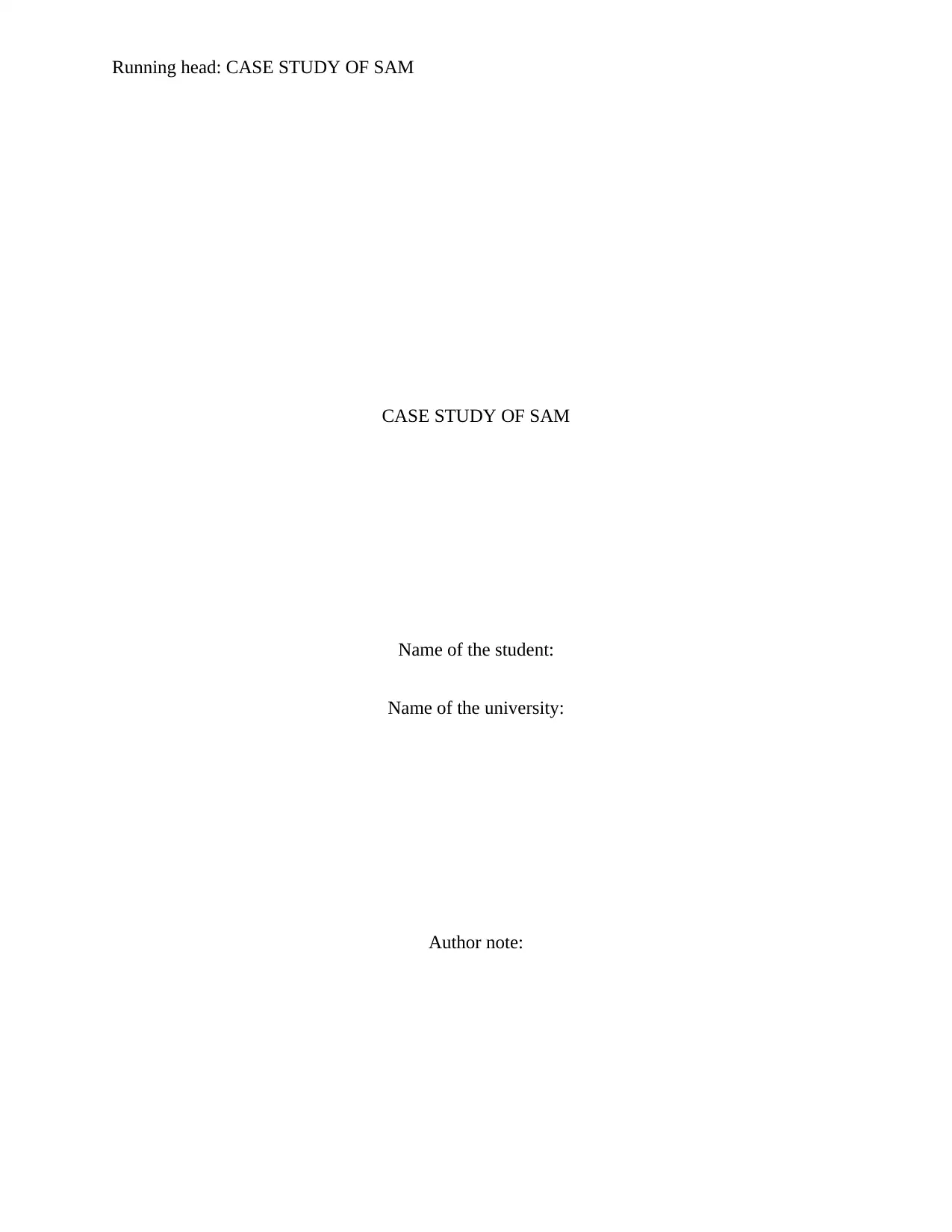
Running head: CASE STUDY OF SAM
CASE STUDY OF SAM
Name of the student:
Name of the university:
Author note:
CASE STUDY OF SAM
Name of the student:
Name of the university:
Author note:
Paraphrase This Document
Need a fresh take? Get an instant paraphrase of this document with our AI Paraphraser
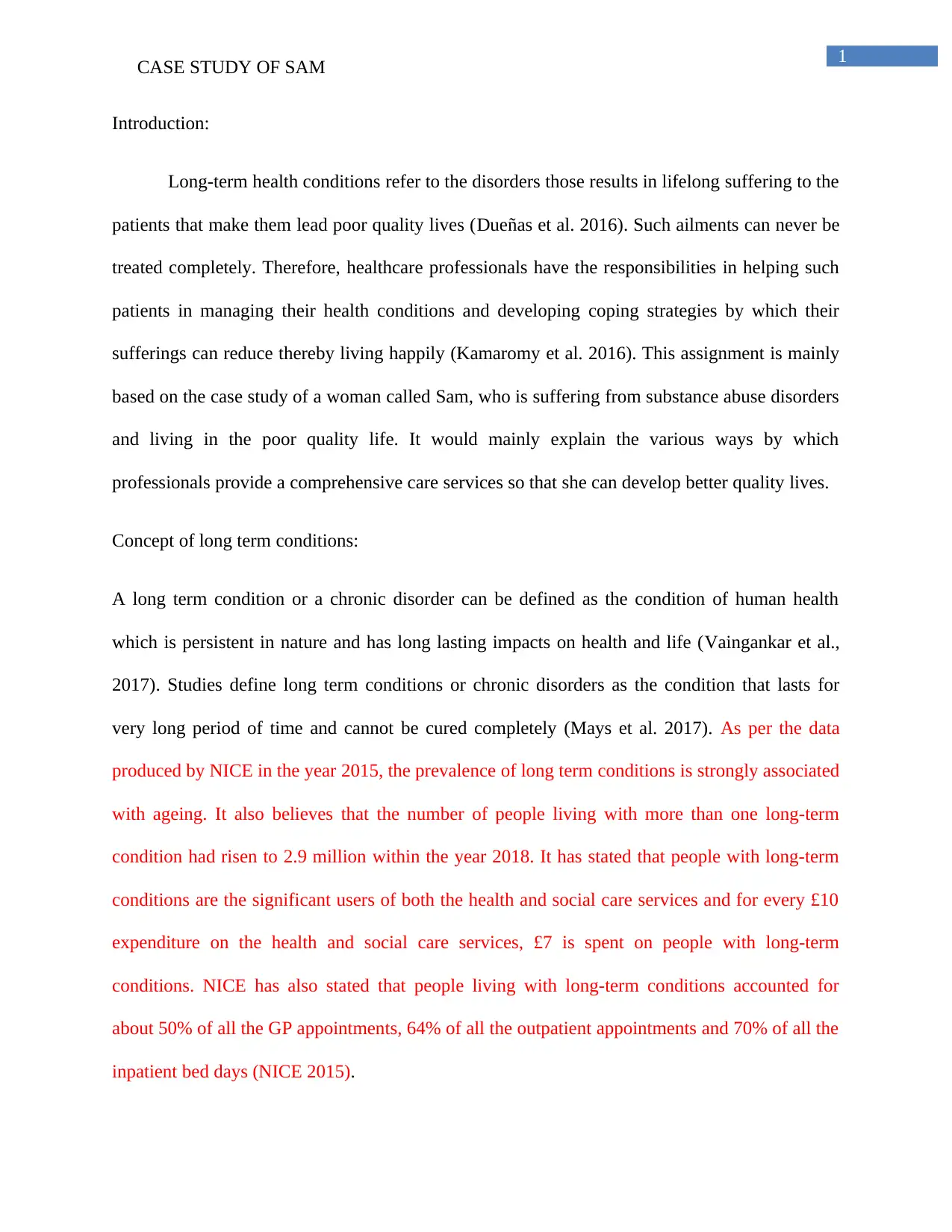
1
CASE STUDY OF SAM
Introduction:
Long-term health conditions refer to the disorders those results in lifelong suffering to the
patients that make them lead poor quality lives (Dueñas et al. 2016). Such ailments can never be
treated completely. Therefore, healthcare professionals have the responsibilities in helping such
patients in managing their health conditions and developing coping strategies by which their
sufferings can reduce thereby living happily (Kamaromy et al. 2016). This assignment is mainly
based on the case study of a woman called Sam, who is suffering from substance abuse disorders
and living in the poor quality life. It would mainly explain the various ways by which
professionals provide a comprehensive care services so that she can develop better quality lives.
Concept of long term conditions:
A long term condition or a chronic disorder can be defined as the condition of human health
which is persistent in nature and has long lasting impacts on health and life (Vaingankar et al.,
2017). Studies define long term conditions or chronic disorders as the condition that lasts for
very long period of time and cannot be cured completely (Mays et al. 2017). As per the data
produced by NICE in the year 2015, the prevalence of long term conditions is strongly associated
with ageing. It also believes that the number of people living with more than one long-term
condition had risen to 2.9 million within the year 2018. It has stated that people with long-term
conditions are the significant users of both the health and social care services and for every £10
expenditure on the health and social care services, £7 is spent on people with long-term
conditions. NICE has also stated that people living with long-term conditions accounted for
about 50% of all the GP appointments, 64% of all the outpatient appointments and 70% of all the
inpatient bed days (NICE 2015).
CASE STUDY OF SAM
Introduction:
Long-term health conditions refer to the disorders those results in lifelong suffering to the
patients that make them lead poor quality lives (Dueñas et al. 2016). Such ailments can never be
treated completely. Therefore, healthcare professionals have the responsibilities in helping such
patients in managing their health conditions and developing coping strategies by which their
sufferings can reduce thereby living happily (Kamaromy et al. 2016). This assignment is mainly
based on the case study of a woman called Sam, who is suffering from substance abuse disorders
and living in the poor quality life. It would mainly explain the various ways by which
professionals provide a comprehensive care services so that she can develop better quality lives.
Concept of long term conditions:
A long term condition or a chronic disorder can be defined as the condition of human health
which is persistent in nature and has long lasting impacts on health and life (Vaingankar et al.,
2017). Studies define long term conditions or chronic disorders as the condition that lasts for
very long period of time and cannot be cured completely (Mays et al. 2017). As per the data
produced by NICE in the year 2015, the prevalence of long term conditions is strongly associated
with ageing. It also believes that the number of people living with more than one long-term
condition had risen to 2.9 million within the year 2018. It has stated that people with long-term
conditions are the significant users of both the health and social care services and for every £10
expenditure on the health and social care services, £7 is spent on people with long-term
conditions. NICE has also stated that people living with long-term conditions accounted for
about 50% of all the GP appointments, 64% of all the outpatient appointments and 70% of all the
inpatient bed days (NICE 2015).
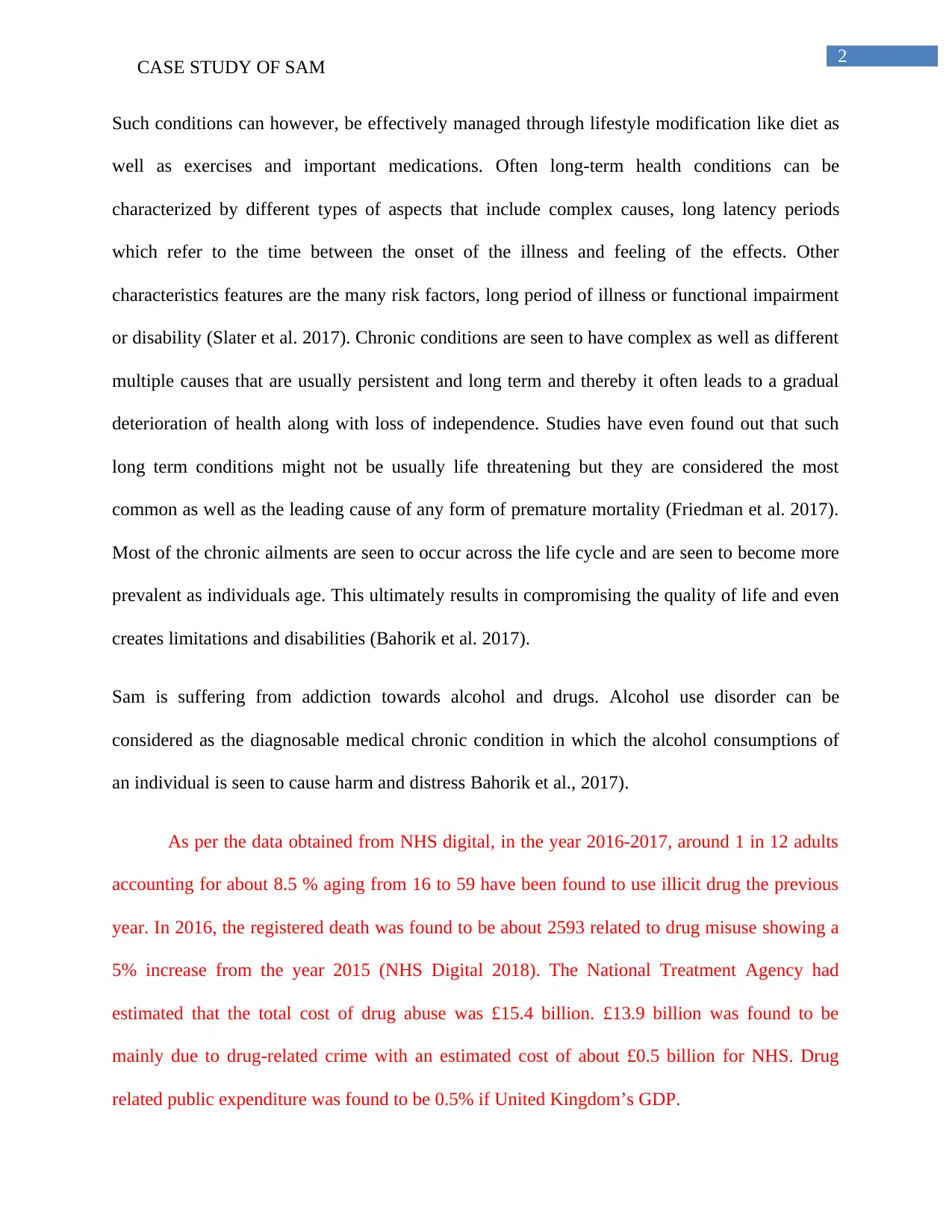
2
CASE STUDY OF SAM
Such conditions can however, be effectively managed through lifestyle modification like diet as
well as exercises and important medications. Often long-term health conditions can be
characterized by different types of aspects that include complex causes, long latency periods
which refer to the time between the onset of the illness and feeling of the effects. Other
characteristics features are the many risk factors, long period of illness or functional impairment
or disability (Slater et al. 2017). Chronic conditions are seen to have complex as well as different
multiple causes that are usually persistent and long term and thereby it often leads to a gradual
deterioration of health along with loss of independence. Studies have even found out that such
long term conditions might not be usually life threatening but they are considered the most
common as well as the leading cause of any form of premature mortality (Friedman et al. 2017).
Most of the chronic ailments are seen to occur across the life cycle and are seen to become more
prevalent as individuals age. This ultimately results in compromising the quality of life and even
creates limitations and disabilities (Bahorik et al. 2017).
Sam is suffering from addiction towards alcohol and drugs. Alcohol use disorder can be
considered as the diagnosable medical chronic condition in which the alcohol consumptions of
an individual is seen to cause harm and distress Bahorik et al., 2017).
As per the data obtained from NHS digital, in the year 2016-2017, around 1 in 12 adults
accounting for about 8.5 % aging from 16 to 59 have been found to use illicit drug the previous
year. In 2016, the registered death was found to be about 2593 related to drug misuse showing a
5% increase from the year 2015 (NHS Digital 2018). The National Treatment Agency had
estimated that the total cost of drug abuse was £15.4 billion. £13.9 billion was found to be
mainly due to drug-related crime with an estimated cost of about £0.5 billion for NHS. Drug
related public expenditure was found to be 0.5% if United Kingdom’s GDP.
CASE STUDY OF SAM
Such conditions can however, be effectively managed through lifestyle modification like diet as
well as exercises and important medications. Often long-term health conditions can be
characterized by different types of aspects that include complex causes, long latency periods
which refer to the time between the onset of the illness and feeling of the effects. Other
characteristics features are the many risk factors, long period of illness or functional impairment
or disability (Slater et al. 2017). Chronic conditions are seen to have complex as well as different
multiple causes that are usually persistent and long term and thereby it often leads to a gradual
deterioration of health along with loss of independence. Studies have even found out that such
long term conditions might not be usually life threatening but they are considered the most
common as well as the leading cause of any form of premature mortality (Friedman et al. 2017).
Most of the chronic ailments are seen to occur across the life cycle and are seen to become more
prevalent as individuals age. This ultimately results in compromising the quality of life and even
creates limitations and disabilities (Bahorik et al. 2017).
Sam is suffering from addiction towards alcohol and drugs. Alcohol use disorder can be
considered as the diagnosable medical chronic condition in which the alcohol consumptions of
an individual is seen to cause harm and distress Bahorik et al., 2017).
As per the data obtained from NHS digital, in the year 2016-2017, around 1 in 12 adults
accounting for about 8.5 % aging from 16 to 59 have been found to use illicit drug the previous
year. In 2016, the registered death was found to be about 2593 related to drug misuse showing a
5% increase from the year 2015 (NHS Digital 2018). The National Treatment Agency had
estimated that the total cost of drug abuse was £15.4 billion. £13.9 billion was found to be
mainly due to drug-related crime with an estimated cost of about £0.5 billion for NHS. Drug
related public expenditure was found to be 0.5% if United Kingdom’s GDP.
⊘ This is a preview!⊘
Do you want full access?
Subscribe today to unlock all pages.

Trusted by 1+ million students worldwide
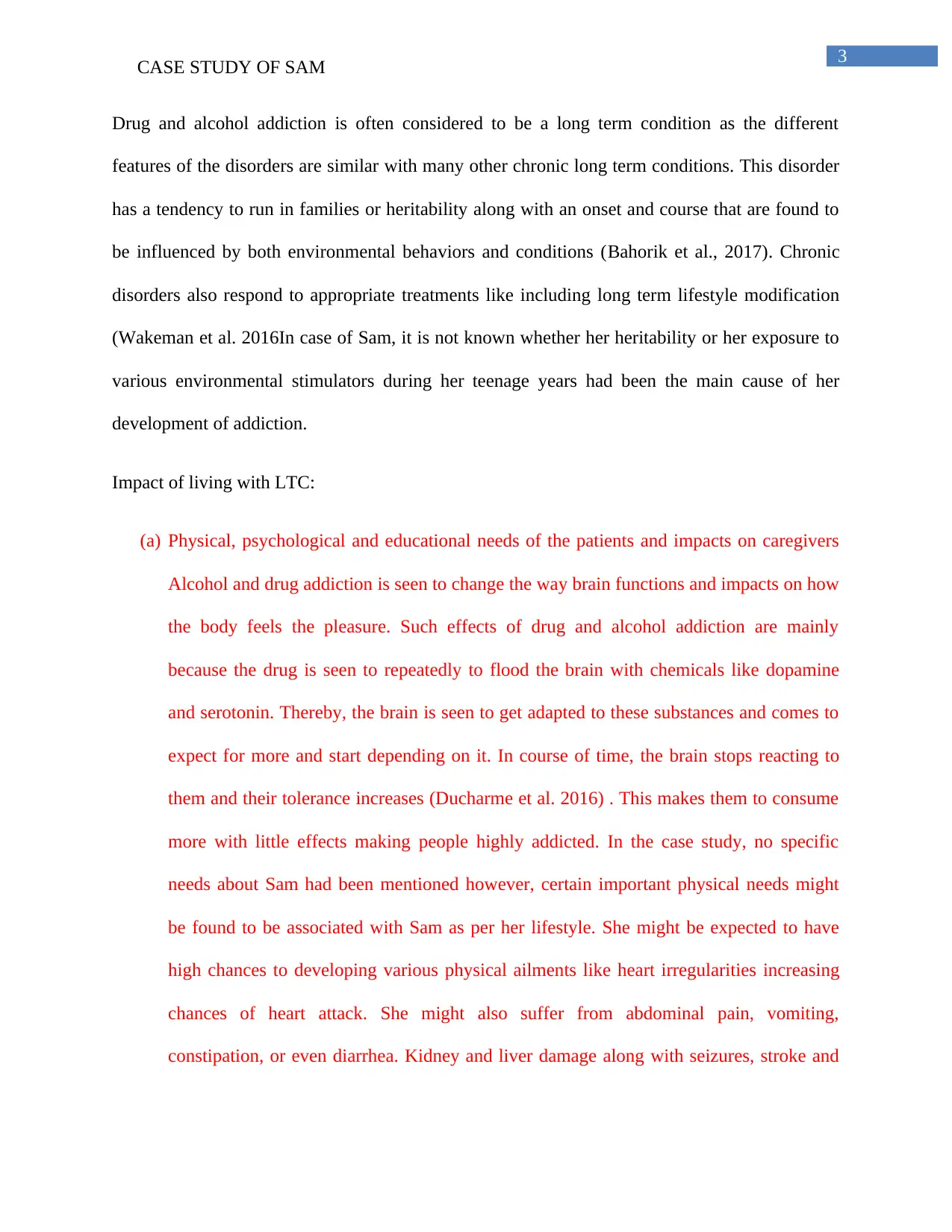
3
CASE STUDY OF SAM
Drug and alcohol addiction is often considered to be a long term condition as the different
features of the disorders are similar with many other chronic long term conditions. This disorder
has a tendency to run in families or heritability along with an onset and course that are found to
be influenced by both environmental behaviors and conditions (Bahorik et al., 2017). Chronic
disorders also respond to appropriate treatments like including long term lifestyle modification
(Wakeman et al. 2016In case of Sam, it is not known whether her heritability or her exposure to
various environmental stimulators during her teenage years had been the main cause of her
development of addiction.
Impact of living with LTC:
(a) Physical, psychological and educational needs of the patients and impacts on caregivers
Alcohol and drug addiction is seen to change the way brain functions and impacts on how
the body feels the pleasure. Such effects of drug and alcohol addiction are mainly
because the drug is seen to repeatedly to flood the brain with chemicals like dopamine
and serotonin. Thereby, the brain is seen to get adapted to these substances and comes to
expect for more and start depending on it. In course of time, the brain stops reacting to
them and their tolerance increases (Ducharme et al. 2016) . This makes them to consume
more with little effects making people highly addicted. In the case study, no specific
needs about Sam had been mentioned however, certain important physical needs might
be found to be associated with Sam as per her lifestyle. She might be expected to have
high chances to developing various physical ailments like heart irregularities increasing
chances of heart attack. She might also suffer from abdominal pain, vomiting,
constipation, or even diarrhea. Kidney and liver damage along with seizures, stroke and
CASE STUDY OF SAM
Drug and alcohol addiction is often considered to be a long term condition as the different
features of the disorders are similar with many other chronic long term conditions. This disorder
has a tendency to run in families or heritability along with an onset and course that are found to
be influenced by both environmental behaviors and conditions (Bahorik et al., 2017). Chronic
disorders also respond to appropriate treatments like including long term lifestyle modification
(Wakeman et al. 2016In case of Sam, it is not known whether her heritability or her exposure to
various environmental stimulators during her teenage years had been the main cause of her
development of addiction.
Impact of living with LTC:
(a) Physical, psychological and educational needs of the patients and impacts on caregivers
Alcohol and drug addiction is seen to change the way brain functions and impacts on how
the body feels the pleasure. Such effects of drug and alcohol addiction are mainly
because the drug is seen to repeatedly to flood the brain with chemicals like dopamine
and serotonin. Thereby, the brain is seen to get adapted to these substances and comes to
expect for more and start depending on it. In course of time, the brain stops reacting to
them and their tolerance increases (Ducharme et al. 2016) . This makes them to consume
more with little effects making people highly addicted. In the case study, no specific
needs about Sam had been mentioned however, certain important physical needs might
be found to be associated with Sam as per her lifestyle. She might be expected to have
high chances to developing various physical ailments like heart irregularities increasing
chances of heart attack. She might also suffer from abdominal pain, vomiting,
constipation, or even diarrhea. Kidney and liver damage along with seizures, stroke and
Paraphrase This Document
Need a fresh take? Get an instant paraphrase of this document with our AI Paraphraser
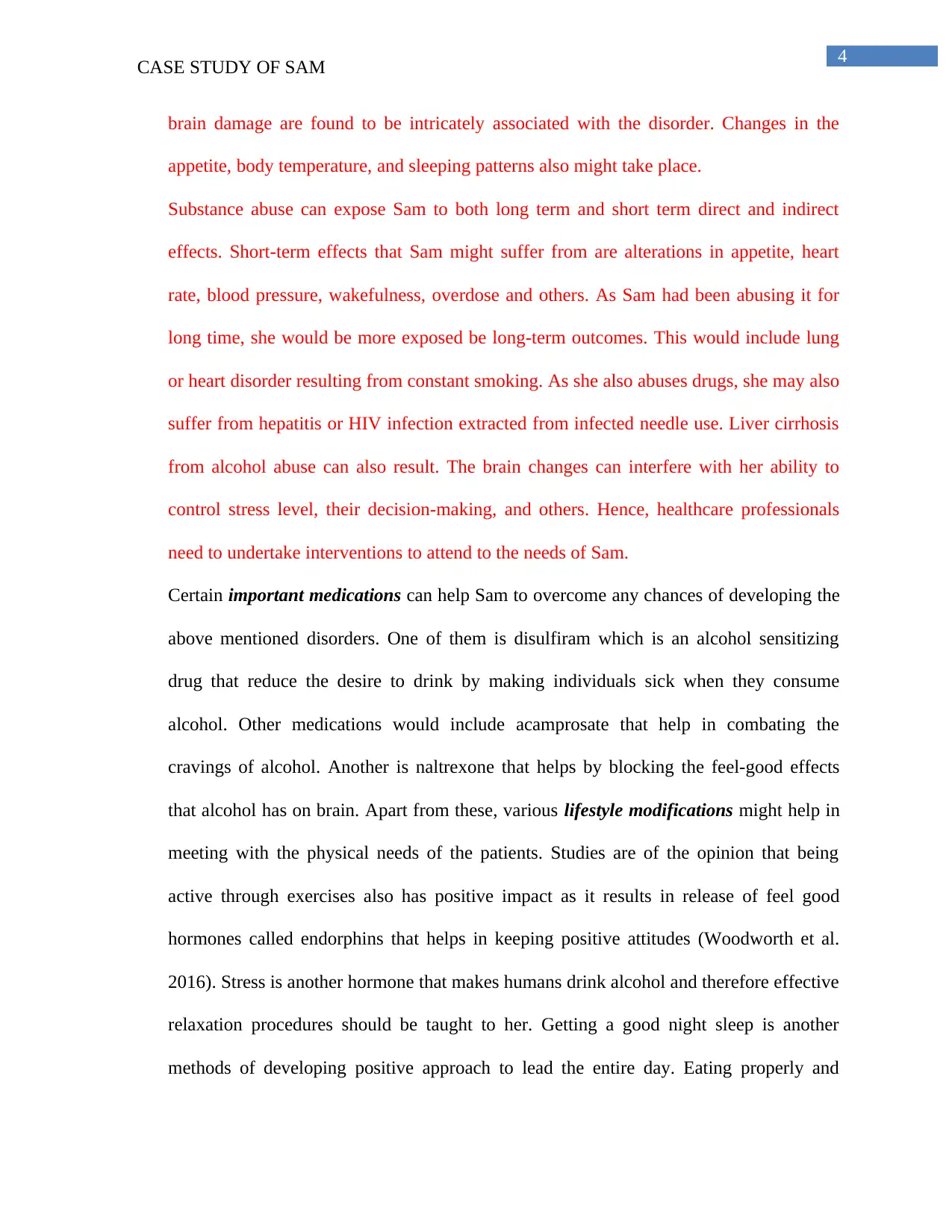
4
CASE STUDY OF SAM
brain damage are found to be intricately associated with the disorder. Changes in the
appetite, body temperature, and sleeping patterns also might take place.
Substance abuse can expose Sam to both long term and short term direct and indirect
effects. Short-term effects that Sam might suffer from are alterations in appetite, heart
rate, blood pressure, wakefulness, overdose and others. As Sam had been abusing it for
long time, she would be more exposed be long-term outcomes. This would include lung
or heart disorder resulting from constant smoking. As she also abuses drugs, she may also
suffer from hepatitis or HIV infection extracted from infected needle use. Liver cirrhosis
from alcohol abuse can also result. The brain changes can interfere with her ability to
control stress level, their decision-making, and others. Hence, healthcare professionals
need to undertake interventions to attend to the needs of Sam.
Certain important medications can help Sam to overcome any chances of developing the
above mentioned disorders. One of them is disulfiram which is an alcohol sensitizing
drug that reduce the desire to drink by making individuals sick when they consume
alcohol. Other medications would include acamprosate that help in combating the
cravings of alcohol. Another is naltrexone that helps by blocking the feel-good effects
that alcohol has on brain. Apart from these, various lifestyle modifications might help in
meeting with the physical needs of the patients. Studies are of the opinion that being
active through exercises also has positive impact as it results in release of feel good
hormones called endorphins that helps in keeping positive attitudes (Woodworth et al.
2016). Stress is another hormone that makes humans drink alcohol and therefore effective
relaxation procedures should be taught to her. Getting a good night sleep is another
methods of developing positive approach to lead the entire day. Eating properly and
CASE STUDY OF SAM
brain damage are found to be intricately associated with the disorder. Changes in the
appetite, body temperature, and sleeping patterns also might take place.
Substance abuse can expose Sam to both long term and short term direct and indirect
effects. Short-term effects that Sam might suffer from are alterations in appetite, heart
rate, blood pressure, wakefulness, overdose and others. As Sam had been abusing it for
long time, she would be more exposed be long-term outcomes. This would include lung
or heart disorder resulting from constant smoking. As she also abuses drugs, she may also
suffer from hepatitis or HIV infection extracted from infected needle use. Liver cirrhosis
from alcohol abuse can also result. The brain changes can interfere with her ability to
control stress level, their decision-making, and others. Hence, healthcare professionals
need to undertake interventions to attend to the needs of Sam.
Certain important medications can help Sam to overcome any chances of developing the
above mentioned disorders. One of them is disulfiram which is an alcohol sensitizing
drug that reduce the desire to drink by making individuals sick when they consume
alcohol. Other medications would include acamprosate that help in combating the
cravings of alcohol. Another is naltrexone that helps by blocking the feel-good effects
that alcohol has on brain. Apart from these, various lifestyle modifications might help in
meeting with the physical needs of the patients. Studies are of the opinion that being
active through exercises also has positive impact as it results in release of feel good
hormones called endorphins that helps in keeping positive attitudes (Woodworth et al.
2016). Stress is another hormone that makes humans drink alcohol and therefore effective
relaxation procedures should be taught to her. Getting a good night sleep is another
methods of developing positive approach to lead the entire day. Eating properly and
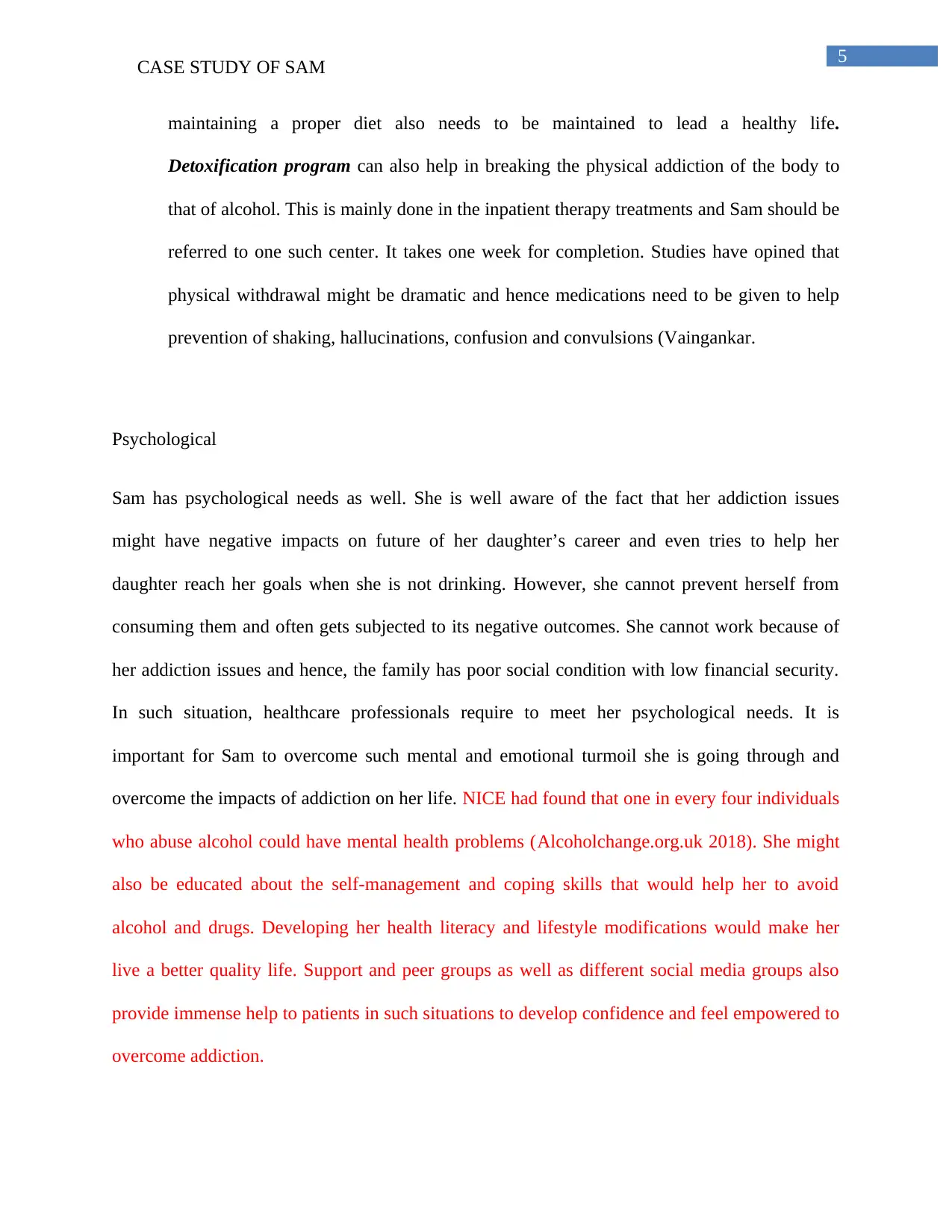
5
CASE STUDY OF SAM
maintaining a proper diet also needs to be maintained to lead a healthy life.
Detoxification program can also help in breaking the physical addiction of the body to
that of alcohol. This is mainly done in the inpatient therapy treatments and Sam should be
referred to one such center. It takes one week for completion. Studies have opined that
physical withdrawal might be dramatic and hence medications need to be given to help
prevention of shaking, hallucinations, confusion and convulsions (Vaingankar.
Psychological
Sam has psychological needs as well. She is well aware of the fact that her addiction issues
might have negative impacts on future of her daughter’s career and even tries to help her
daughter reach her goals when she is not drinking. However, she cannot prevent herself from
consuming them and often gets subjected to its negative outcomes. She cannot work because of
her addiction issues and hence, the family has poor social condition with low financial security.
In such situation, healthcare professionals require to meet her psychological needs. It is
important for Sam to overcome such mental and emotional turmoil she is going through and
overcome the impacts of addiction on her life. NICE had found that one in every four individuals
who abuse alcohol could have mental health problems (Alcoholchange.org.uk 2018). She might
also be educated about the self-management and coping skills that would help her to avoid
alcohol and drugs. Developing her health literacy and lifestyle modifications would make her
live a better quality life. Support and peer groups as well as different social media groups also
provide immense help to patients in such situations to develop confidence and feel empowered to
overcome addiction.
CASE STUDY OF SAM
maintaining a proper diet also needs to be maintained to lead a healthy life.
Detoxification program can also help in breaking the physical addiction of the body to
that of alcohol. This is mainly done in the inpatient therapy treatments and Sam should be
referred to one such center. It takes one week for completion. Studies have opined that
physical withdrawal might be dramatic and hence medications need to be given to help
prevention of shaking, hallucinations, confusion and convulsions (Vaingankar.
Psychological
Sam has psychological needs as well. She is well aware of the fact that her addiction issues
might have negative impacts on future of her daughter’s career and even tries to help her
daughter reach her goals when she is not drinking. However, she cannot prevent herself from
consuming them and often gets subjected to its negative outcomes. She cannot work because of
her addiction issues and hence, the family has poor social condition with low financial security.
In such situation, healthcare professionals require to meet her psychological needs. It is
important for Sam to overcome such mental and emotional turmoil she is going through and
overcome the impacts of addiction on her life. NICE had found that one in every four individuals
who abuse alcohol could have mental health problems (Alcoholchange.org.uk 2018). She might
also be educated about the self-management and coping skills that would help her to avoid
alcohol and drugs. Developing her health literacy and lifestyle modifications would make her
live a better quality life. Support and peer groups as well as different social media groups also
provide immense help to patients in such situations to develop confidence and feel empowered to
overcome addiction.
⊘ This is a preview!⊘
Do you want full access?
Subscribe today to unlock all pages.

Trusted by 1+ million students worldwide
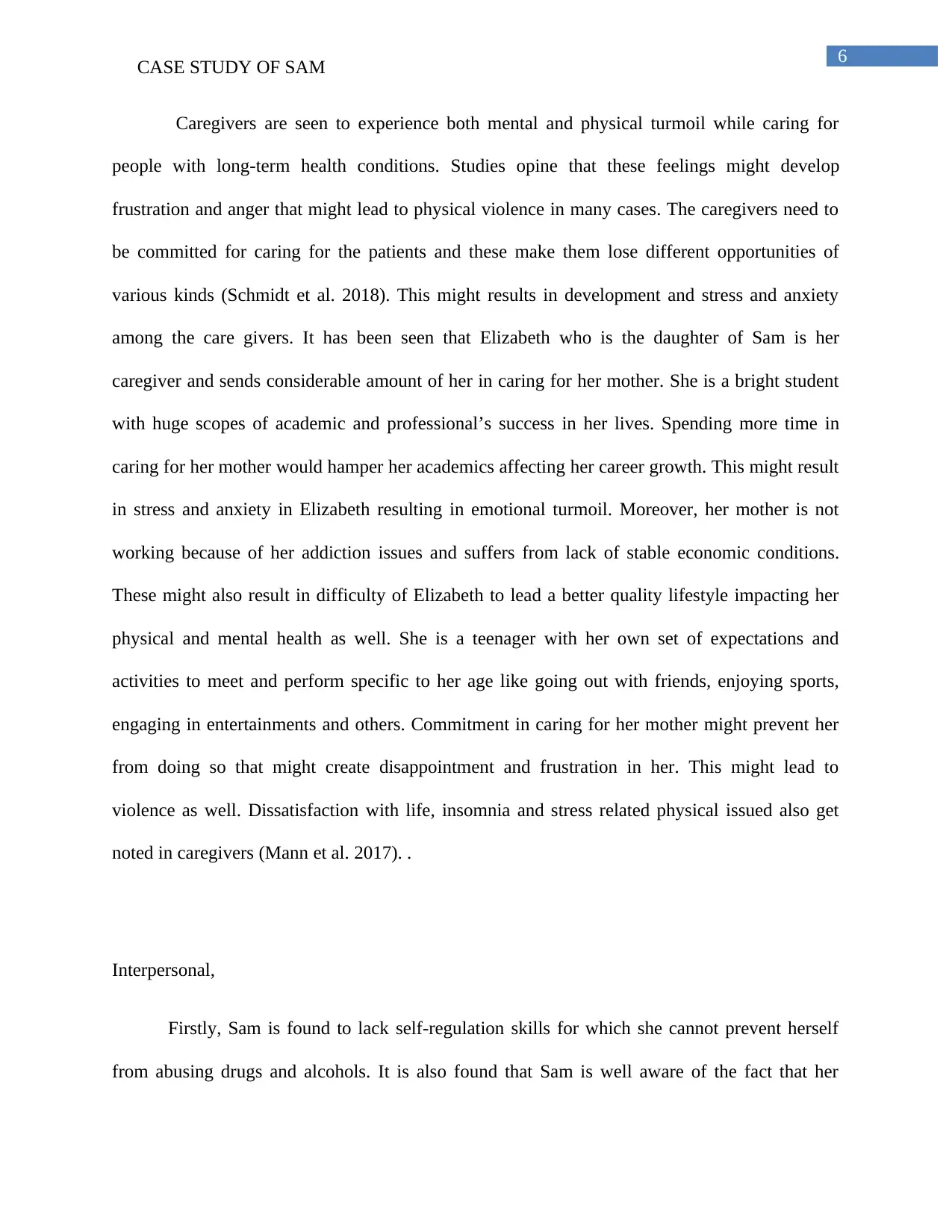
6
CASE STUDY OF SAM
Caregivers are seen to experience both mental and physical turmoil while caring for
people with long-term health conditions. Studies opine that these feelings might develop
frustration and anger that might lead to physical violence in many cases. The caregivers need to
be committed for caring for the patients and these make them lose different opportunities of
various kinds (Schmidt et al. 2018). This might results in development and stress and anxiety
among the care givers. It has been seen that Elizabeth who is the daughter of Sam is her
caregiver and sends considerable amount of her in caring for her mother. She is a bright student
with huge scopes of academic and professional’s success in her lives. Spending more time in
caring for her mother would hamper her academics affecting her career growth. This might result
in stress and anxiety in Elizabeth resulting in emotional turmoil. Moreover, her mother is not
working because of her addiction issues and suffers from lack of stable economic conditions.
These might also result in difficulty of Elizabeth to lead a better quality lifestyle impacting her
physical and mental health as well. She is a teenager with her own set of expectations and
activities to meet and perform specific to her age like going out with friends, enjoying sports,
engaging in entertainments and others. Commitment in caring for her mother might prevent her
from doing so that might create disappointment and frustration in her. This might lead to
violence as well. Dissatisfaction with life, insomnia and stress related physical issued also get
noted in caregivers (Mann et al. 2017). .
Interpersonal,
Firstly, Sam is found to lack self-regulation skills for which she cannot prevent herself
from abusing drugs and alcohols. It is also found that Sam is well aware of the fact that her
CASE STUDY OF SAM
Caregivers are seen to experience both mental and physical turmoil while caring for
people with long-term health conditions. Studies opine that these feelings might develop
frustration and anger that might lead to physical violence in many cases. The caregivers need to
be committed for caring for the patients and these make them lose different opportunities of
various kinds (Schmidt et al. 2018). This might results in development and stress and anxiety
among the care givers. It has been seen that Elizabeth who is the daughter of Sam is her
caregiver and sends considerable amount of her in caring for her mother. She is a bright student
with huge scopes of academic and professional’s success in her lives. Spending more time in
caring for her mother would hamper her academics affecting her career growth. This might result
in stress and anxiety in Elizabeth resulting in emotional turmoil. Moreover, her mother is not
working because of her addiction issues and suffers from lack of stable economic conditions.
These might also result in difficulty of Elizabeth to lead a better quality lifestyle impacting her
physical and mental health as well. She is a teenager with her own set of expectations and
activities to meet and perform specific to her age like going out with friends, enjoying sports,
engaging in entertainments and others. Commitment in caring for her mother might prevent her
from doing so that might create disappointment and frustration in her. This might lead to
violence as well. Dissatisfaction with life, insomnia and stress related physical issued also get
noted in caregivers (Mann et al. 2017). .
Interpersonal,
Firstly, Sam is found to lack self-regulation skills for which she cannot prevent herself
from abusing drugs and alcohols. It is also found that Sam is well aware of the fact that her
Paraphrase This Document
Need a fresh take? Get an instant paraphrase of this document with our AI Paraphraser
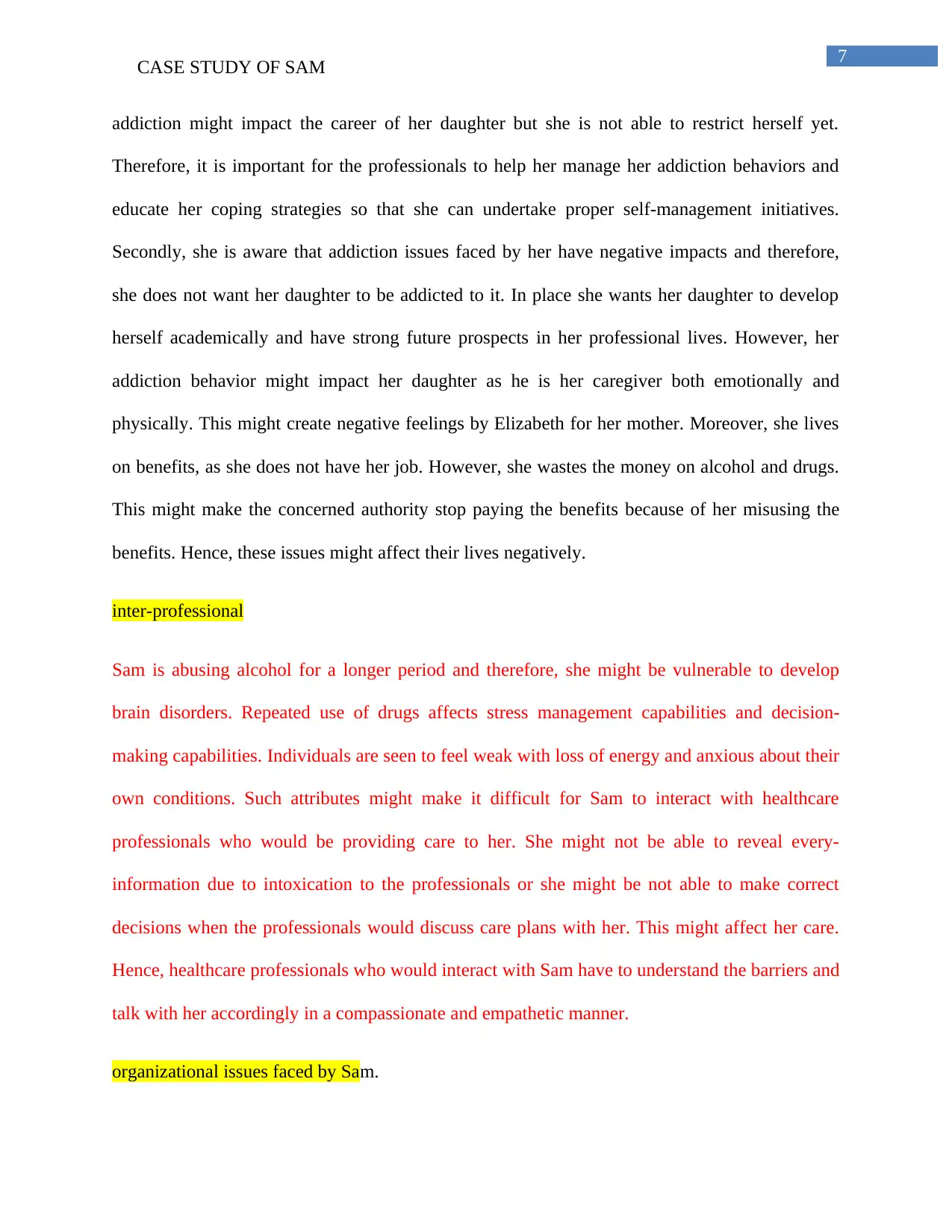
7
CASE STUDY OF SAM
addiction might impact the career of her daughter but she is not able to restrict herself yet.
Therefore, it is important for the professionals to help her manage her addiction behaviors and
educate her coping strategies so that she can undertake proper self-management initiatives.
Secondly, she is aware that addiction issues faced by her have negative impacts and therefore,
she does not want her daughter to be addicted to it. In place she wants her daughter to develop
herself academically and have strong future prospects in her professional lives. However, her
addiction behavior might impact her daughter as he is her caregiver both emotionally and
physically. This might create negative feelings by Elizabeth for her mother. Moreover, she lives
on benefits, as she does not have her job. However, she wastes the money on alcohol and drugs.
This might make the concerned authority stop paying the benefits because of her misusing the
benefits. Hence, these issues might affect their lives negatively.
inter-professional
Sam is abusing alcohol for a longer period and therefore, she might be vulnerable to develop
brain disorders. Repeated use of drugs affects stress management capabilities and decision-
making capabilities. Individuals are seen to feel weak with loss of energy and anxious about their
own conditions. Such attributes might make it difficult for Sam to interact with healthcare
professionals who would be providing care to her. She might not be able to reveal every-
information due to intoxication to the professionals or she might be not able to make correct
decisions when the professionals would discuss care plans with her. This might affect her care.
Hence, healthcare professionals who would interact with Sam have to understand the barriers and
talk with her accordingly in a compassionate and empathetic manner.
organizational issues faced by Sam.
CASE STUDY OF SAM
addiction might impact the career of her daughter but she is not able to restrict herself yet.
Therefore, it is important for the professionals to help her manage her addiction behaviors and
educate her coping strategies so that she can undertake proper self-management initiatives.
Secondly, she is aware that addiction issues faced by her have negative impacts and therefore,
she does not want her daughter to be addicted to it. In place she wants her daughter to develop
herself academically and have strong future prospects in her professional lives. However, her
addiction behavior might impact her daughter as he is her caregiver both emotionally and
physically. This might create negative feelings by Elizabeth for her mother. Moreover, she lives
on benefits, as she does not have her job. However, she wastes the money on alcohol and drugs.
This might make the concerned authority stop paying the benefits because of her misusing the
benefits. Hence, these issues might affect their lives negatively.
inter-professional
Sam is abusing alcohol for a longer period and therefore, she might be vulnerable to develop
brain disorders. Repeated use of drugs affects stress management capabilities and decision-
making capabilities. Individuals are seen to feel weak with loss of energy and anxious about their
own conditions. Such attributes might make it difficult for Sam to interact with healthcare
professionals who would be providing care to her. She might not be able to reveal every-
information due to intoxication to the professionals or she might be not able to make correct
decisions when the professionals would discuss care plans with her. This might affect her care.
Hence, healthcare professionals who would interact with Sam have to understand the barriers and
talk with her accordingly in a compassionate and empathetic manner.
organizational issues faced by Sam.
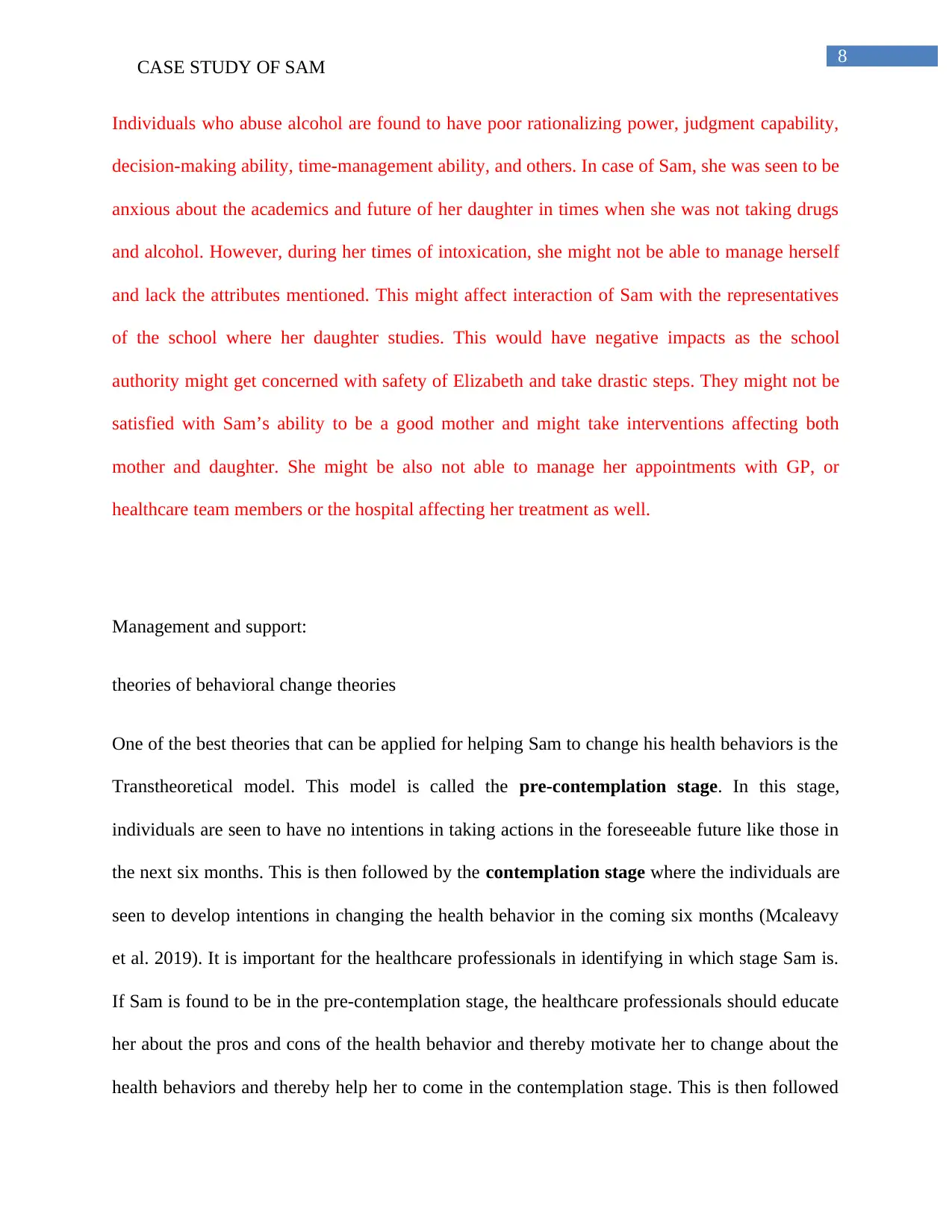
8
CASE STUDY OF SAM
Individuals who abuse alcohol are found to have poor rationalizing power, judgment capability,
decision-making ability, time-management ability, and others. In case of Sam, she was seen to be
anxious about the academics and future of her daughter in times when she was not taking drugs
and alcohol. However, during her times of intoxication, she might not be able to manage herself
and lack the attributes mentioned. This might affect interaction of Sam with the representatives
of the school where her daughter studies. This would have negative impacts as the school
authority might get concerned with safety of Elizabeth and take drastic steps. They might not be
satisfied with Sam’s ability to be a good mother and might take interventions affecting both
mother and daughter. She might be also not able to manage her appointments with GP, or
healthcare team members or the hospital affecting her treatment as well.
Management and support:
theories of behavioral change theories
One of the best theories that can be applied for helping Sam to change his health behaviors is the
Transtheoretical model. This model is called the pre-contemplation stage. In this stage,
individuals are seen to have no intentions in taking actions in the foreseeable future like those in
the next six months. This is then followed by the contemplation stage where the individuals are
seen to develop intentions in changing the health behavior in the coming six months (Mcaleavy
et al. 2019). It is important for the healthcare professionals in identifying in which stage Sam is.
If Sam is found to be in the pre-contemplation stage, the healthcare professionals should educate
her about the pros and cons of the health behavior and thereby motivate her to change about the
health behaviors and thereby help her to come in the contemplation stage. This is then followed
CASE STUDY OF SAM
Individuals who abuse alcohol are found to have poor rationalizing power, judgment capability,
decision-making ability, time-management ability, and others. In case of Sam, she was seen to be
anxious about the academics and future of her daughter in times when she was not taking drugs
and alcohol. However, during her times of intoxication, she might not be able to manage herself
and lack the attributes mentioned. This might affect interaction of Sam with the representatives
of the school where her daughter studies. This would have negative impacts as the school
authority might get concerned with safety of Elizabeth and take drastic steps. They might not be
satisfied with Sam’s ability to be a good mother and might take interventions affecting both
mother and daughter. She might be also not able to manage her appointments with GP, or
healthcare team members or the hospital affecting her treatment as well.
Management and support:
theories of behavioral change theories
One of the best theories that can be applied for helping Sam to change his health behaviors is the
Transtheoretical model. This model is called the pre-contemplation stage. In this stage,
individuals are seen to have no intentions in taking actions in the foreseeable future like those in
the next six months. This is then followed by the contemplation stage where the individuals are
seen to develop intentions in changing the health behavior in the coming six months (Mcaleavy
et al. 2019). It is important for the healthcare professionals in identifying in which stage Sam is.
If Sam is found to be in the pre-contemplation stage, the healthcare professionals should educate
her about the pros and cons of the health behavior and thereby motivate her to change about the
health behaviors and thereby help her to come in the contemplation stage. This is then followed
⊘ This is a preview!⊘
Do you want full access?
Subscribe today to unlock all pages.

Trusted by 1+ million students worldwide
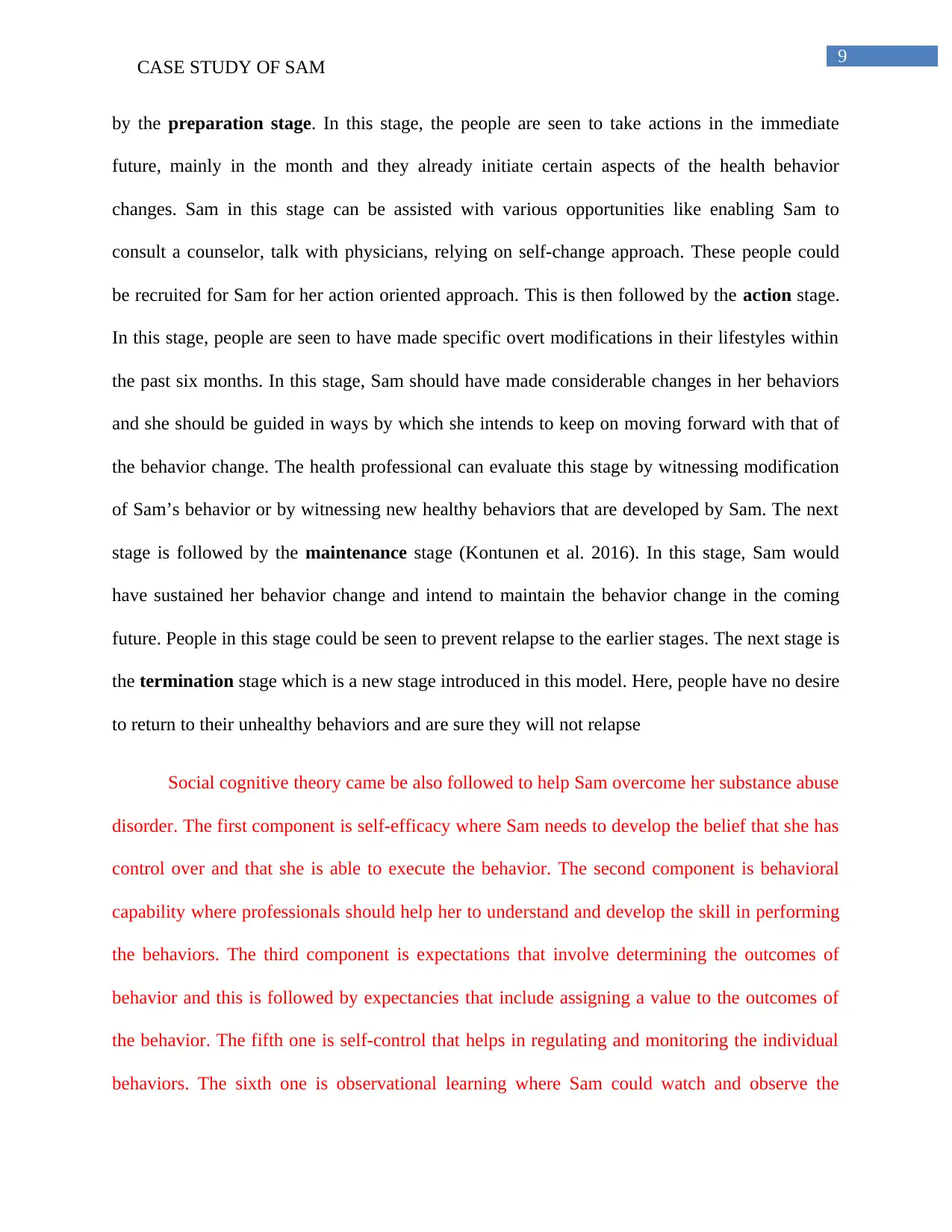
9
CASE STUDY OF SAM
by the preparation stage. In this stage, the people are seen to take actions in the immediate
future, mainly in the month and they already initiate certain aspects of the health behavior
changes. Sam in this stage can be assisted with various opportunities like enabling Sam to
consult a counselor, talk with physicians, relying on self-change approach. These people could
be recruited for Sam for her action oriented approach. This is then followed by the action stage.
In this stage, people are seen to have made specific overt modifications in their lifestyles within
the past six months. In this stage, Sam should have made considerable changes in her behaviors
and she should be guided in ways by which she intends to keep on moving forward with that of
the behavior change. The health professional can evaluate this stage by witnessing modification
of Sam’s behavior or by witnessing new healthy behaviors that are developed by Sam. The next
stage is followed by the maintenance stage (Kontunen et al. 2016). In this stage, Sam would
have sustained her behavior change and intend to maintain the behavior change in the coming
future. People in this stage could be seen to prevent relapse to the earlier stages. The next stage is
the termination stage which is a new stage introduced in this model. Here, people have no desire
to return to their unhealthy behaviors and are sure they will not relapse
Social cognitive theory came be also followed to help Sam overcome her substance abuse
disorder. The first component is self-efficacy where Sam needs to develop the belief that she has
control over and that she is able to execute the behavior. The second component is behavioral
capability where professionals should help her to understand and develop the skill in performing
the behaviors. The third component is expectations that involve determining the outcomes of
behavior and this is followed by expectancies that include assigning a value to the outcomes of
the behavior. The fifth one is self-control that helps in regulating and monitoring the individual
behaviors. The sixth one is observational learning where Sam could watch and observe the
CASE STUDY OF SAM
by the preparation stage. In this stage, the people are seen to take actions in the immediate
future, mainly in the month and they already initiate certain aspects of the health behavior
changes. Sam in this stage can be assisted with various opportunities like enabling Sam to
consult a counselor, talk with physicians, relying on self-change approach. These people could
be recruited for Sam for her action oriented approach. This is then followed by the action stage.
In this stage, people are seen to have made specific overt modifications in their lifestyles within
the past six months. In this stage, Sam should have made considerable changes in her behaviors
and she should be guided in ways by which she intends to keep on moving forward with that of
the behavior change. The health professional can evaluate this stage by witnessing modification
of Sam’s behavior or by witnessing new healthy behaviors that are developed by Sam. The next
stage is followed by the maintenance stage (Kontunen et al. 2016). In this stage, Sam would
have sustained her behavior change and intend to maintain the behavior change in the coming
future. People in this stage could be seen to prevent relapse to the earlier stages. The next stage is
the termination stage which is a new stage introduced in this model. Here, people have no desire
to return to their unhealthy behaviors and are sure they will not relapse
Social cognitive theory came be also followed to help Sam overcome her substance abuse
disorder. The first component is self-efficacy where Sam needs to develop the belief that she has
control over and that she is able to execute the behavior. The second component is behavioral
capability where professionals should help her to understand and develop the skill in performing
the behaviors. The third component is expectations that involve determining the outcomes of
behavior and this is followed by expectancies that include assigning a value to the outcomes of
the behavior. The fifth one is self-control that helps in regulating and monitoring the individual
behaviors. The sixth one is observational learning where Sam could watch and observe the
Paraphrase This Document
Need a fresh take? Get an instant paraphrase of this document with our AI Paraphraser
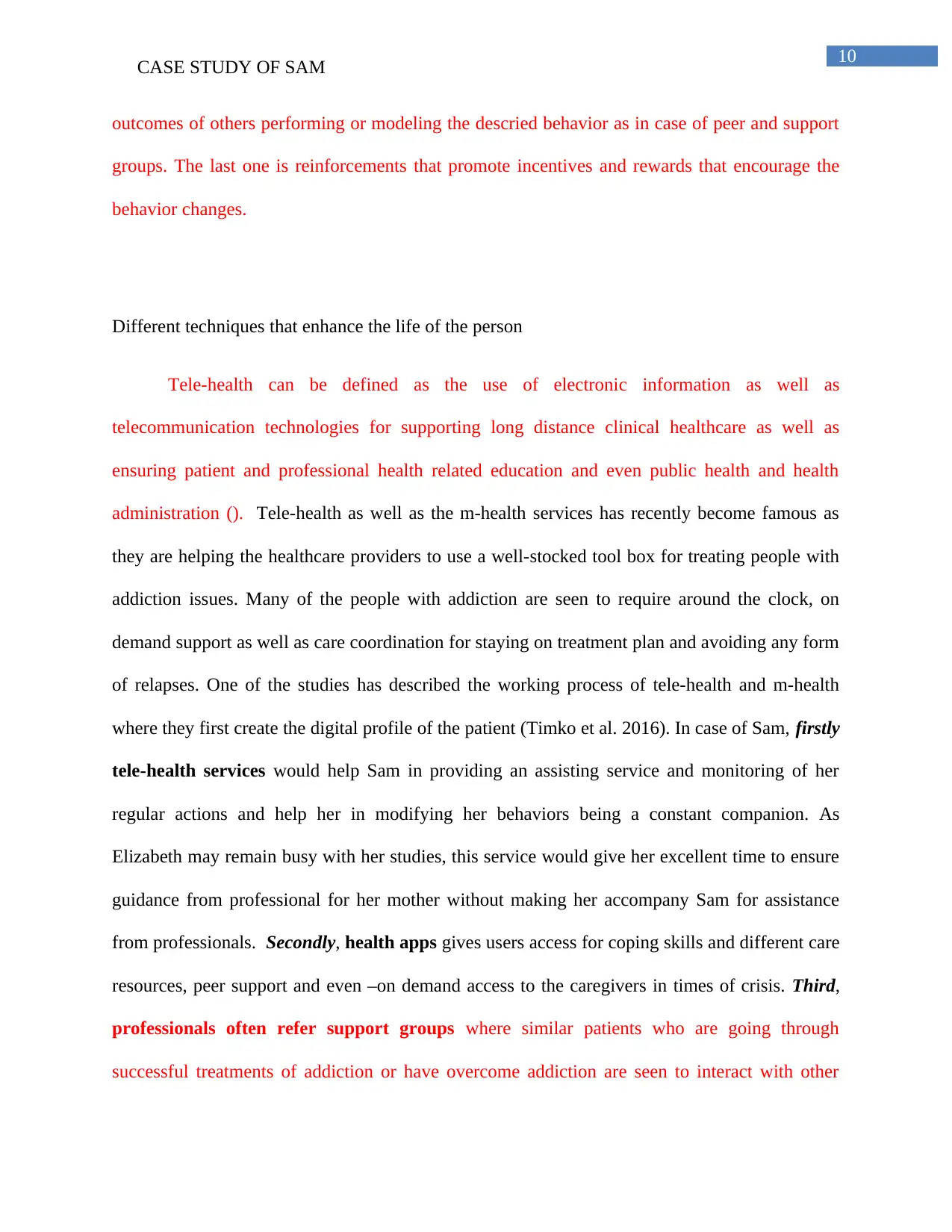
10
CASE STUDY OF SAM
outcomes of others performing or modeling the descried behavior as in case of peer and support
groups. The last one is reinforcements that promote incentives and rewards that encourage the
behavior changes.
Different techniques that enhance the life of the person
Tele-health can be defined as the use of electronic information as well as
telecommunication technologies for supporting long distance clinical healthcare as well as
ensuring patient and professional health related education and even public health and health
administration (). Tele-health as well as the m-health services has recently become famous as
they are helping the healthcare providers to use a well-stocked tool box for treating people with
addiction issues. Many of the people with addiction are seen to require around the clock, on
demand support as well as care coordination for staying on treatment plan and avoiding any form
of relapses. One of the studies has described the working process of tele-health and m-health
where they first create the digital profile of the patient (Timko et al. 2016). In case of Sam, firstly
tele-health services would help Sam in providing an assisting service and monitoring of her
regular actions and help her in modifying her behaviors being a constant companion. As
Elizabeth may remain busy with her studies, this service would give her excellent time to ensure
guidance from professional for her mother without making her accompany Sam for assistance
from professionals. Secondly, health apps gives users access for coping skills and different care
resources, peer support and even –on demand access to the caregivers in times of crisis. Third,
professionals often refer support groups where similar patients who are going through
successful treatments of addiction or have overcome addiction are seen to interact with other
CASE STUDY OF SAM
outcomes of others performing or modeling the descried behavior as in case of peer and support
groups. The last one is reinforcements that promote incentives and rewards that encourage the
behavior changes.
Different techniques that enhance the life of the person
Tele-health can be defined as the use of electronic information as well as
telecommunication technologies for supporting long distance clinical healthcare as well as
ensuring patient and professional health related education and even public health and health
administration (). Tele-health as well as the m-health services has recently become famous as
they are helping the healthcare providers to use a well-stocked tool box for treating people with
addiction issues. Many of the people with addiction are seen to require around the clock, on
demand support as well as care coordination for staying on treatment plan and avoiding any form
of relapses. One of the studies has described the working process of tele-health and m-health
where they first create the digital profile of the patient (Timko et al. 2016). In case of Sam, firstly
tele-health services would help Sam in providing an assisting service and monitoring of her
regular actions and help her in modifying her behaviors being a constant companion. As
Elizabeth may remain busy with her studies, this service would give her excellent time to ensure
guidance from professional for her mother without making her accompany Sam for assistance
from professionals. Secondly, health apps gives users access for coping skills and different care
resources, peer support and even –on demand access to the caregivers in times of crisis. Third,
professionals often refer support groups where similar patients who are going through
successful treatments of addiction or have overcome addiction are seen to interact with other
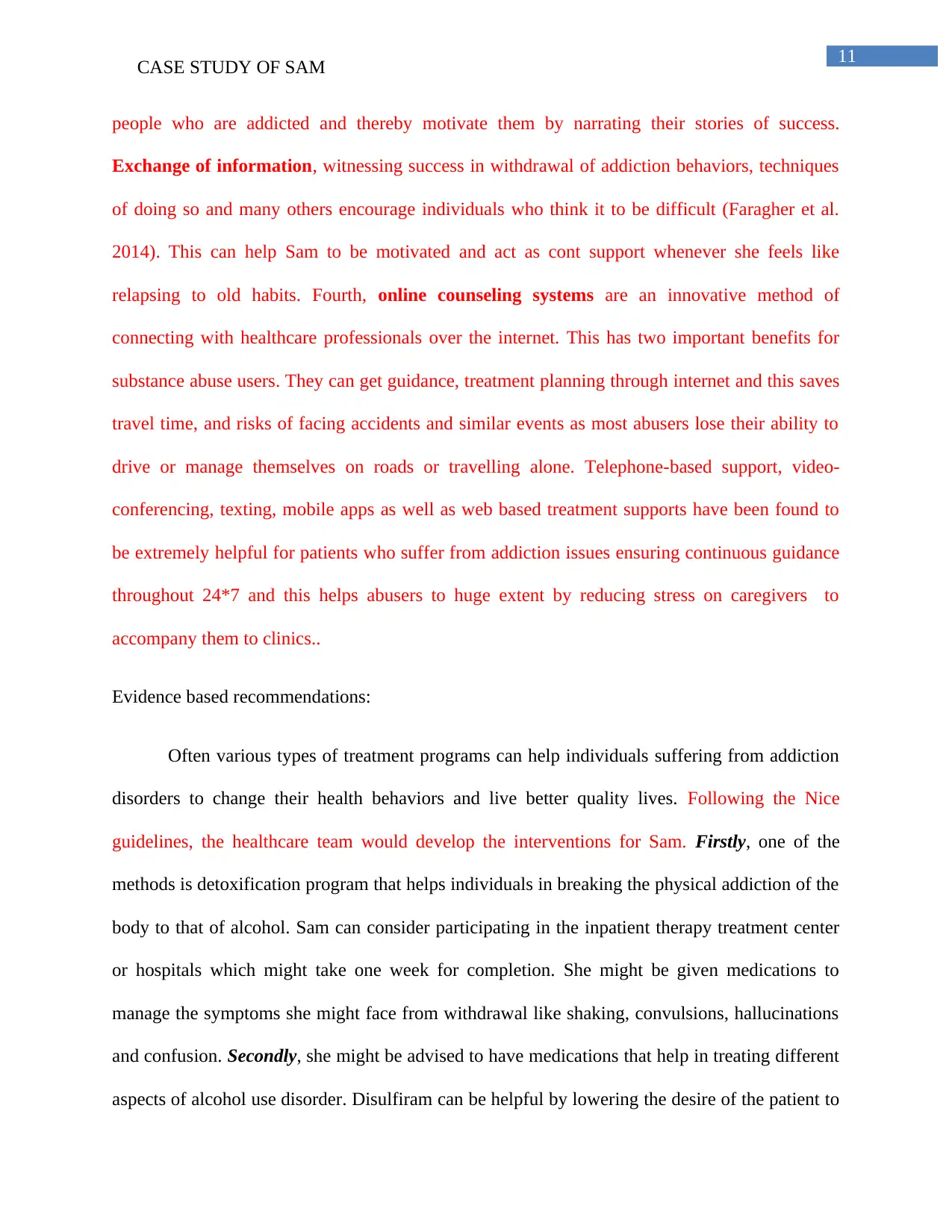
11
CASE STUDY OF SAM
people who are addicted and thereby motivate them by narrating their stories of success.
Exchange of information, witnessing success in withdrawal of addiction behaviors, techniques
of doing so and many others encourage individuals who think it to be difficult (Faragher et al.
2014). This can help Sam to be motivated and act as cont support whenever she feels like
relapsing to old habits. Fourth, online counseling systems are an innovative method of
connecting with healthcare professionals over the internet. This has two important benefits for
substance abuse users. They can get guidance, treatment planning through internet and this saves
travel time, and risks of facing accidents and similar events as most abusers lose their ability to
drive or manage themselves on roads or travelling alone. Telephone-based support, video-
conferencing, texting, mobile apps as well as web based treatment supports have been found to
be extremely helpful for patients who suffer from addiction issues ensuring continuous guidance
throughout 24*7 and this helps abusers to huge extent by reducing stress on caregivers to
accompany them to clinics..
Evidence based recommendations:
Often various types of treatment programs can help individuals suffering from addiction
disorders to change their health behaviors and live better quality lives. Following the Nice
guidelines, the healthcare team would develop the interventions for Sam. Firstly, one of the
methods is detoxification program that helps individuals in breaking the physical addiction of the
body to that of alcohol. Sam can consider participating in the inpatient therapy treatment center
or hospitals which might take one week for completion. She might be given medications to
manage the symptoms she might face from withdrawal like shaking, convulsions, hallucinations
and confusion. Secondly, she might be advised to have medications that help in treating different
aspects of alcohol use disorder. Disulfiram can be helpful by lowering the desire of the patient to
CASE STUDY OF SAM
people who are addicted and thereby motivate them by narrating their stories of success.
Exchange of information, witnessing success in withdrawal of addiction behaviors, techniques
of doing so and many others encourage individuals who think it to be difficult (Faragher et al.
2014). This can help Sam to be motivated and act as cont support whenever she feels like
relapsing to old habits. Fourth, online counseling systems are an innovative method of
connecting with healthcare professionals over the internet. This has two important benefits for
substance abuse users. They can get guidance, treatment planning through internet and this saves
travel time, and risks of facing accidents and similar events as most abusers lose their ability to
drive or manage themselves on roads or travelling alone. Telephone-based support, video-
conferencing, texting, mobile apps as well as web based treatment supports have been found to
be extremely helpful for patients who suffer from addiction issues ensuring continuous guidance
throughout 24*7 and this helps abusers to huge extent by reducing stress on caregivers to
accompany them to clinics..
Evidence based recommendations:
Often various types of treatment programs can help individuals suffering from addiction
disorders to change their health behaviors and live better quality lives. Following the Nice
guidelines, the healthcare team would develop the interventions for Sam. Firstly, one of the
methods is detoxification program that helps individuals in breaking the physical addiction of the
body to that of alcohol. Sam can consider participating in the inpatient therapy treatment center
or hospitals which might take one week for completion. She might be given medications to
manage the symptoms she might face from withdrawal like shaking, convulsions, hallucinations
and confusion. Secondly, she might be advised to have medications that help in treating different
aspects of alcohol use disorder. Disulfiram can be helpful by lowering the desire of the patient to
⊘ This is a preview!⊘
Do you want full access?
Subscribe today to unlock all pages.

Trusted by 1+ million students worldwide
1 out of 19
Related Documents
Your All-in-One AI-Powered Toolkit for Academic Success.
+13062052269
info@desklib.com
Available 24*7 on WhatsApp / Email
![[object Object]](/_next/static/media/star-bottom.7253800d.svg)
Unlock your academic potential
Copyright © 2020–2025 A2Z Services. All Rights Reserved. Developed and managed by ZUCOL.




